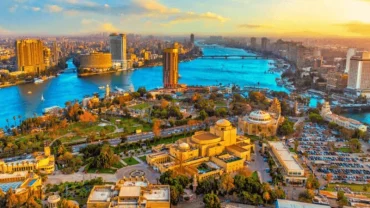Luxor is a city where the brilliance of the sun breathes life into the ancient wonders of Egypt, awakening a deep sense of beauty and awe in those who journey here. For travelers eager to transcend time and experience the grandeur of Egypt’s ancient civilization, Luxor offers an unmatched spectacle. This article aims to provide every visitor with essential insights into the legendary city of Luxor. Crafted by a team of experienced tour guides, operators, and travel consultants, it captures the essence of this magical city.
Luxor, once known as ancient Thebes, is one of the oldest and continuously inhabited cities in the world. It was the capital of Egypt during the New Kingdom, from the 16th to the 11th centuries B.C., earning its title as the city of eternal royalty. Often called the “City of a Hundred Doors,” Luxor is regarded as the world’s greatest open-air museum, home to some of the most magnificent temples.
Luxor Location
Luxor is located in Upper Egypt, about 670 kilometers (416 miles) south of Cairo and 220 kilometers (137 miles) north of Aswan. Straddling the Nile River, Luxor is uniquely positioned with the East Bank hosting the city’s modern amenities, including hotels, museums, and the vibrant Luxor Temple, while the West Bank is famed for its archaeological wonders like the Valley of the Kings and the Valley of the Queens. This strategic location has made Luxor a cultural and historical hub, bridging the past with the present and offering visitors a gateway to explore the splendor of ancient Egypt.
Luxor History
Luxor, historically known as Thebes, is a city deeply intertwined with the religious and cultural fabric of ancient Egypt. Often referred to as the “City of a Hundred Gates” and “City of Amun,” Luxor was the spiritual heart of the Theban Triad, which included Amun-Ra, the sun god and creator; Mut, the goddess of truth and justice; and Khonsu, the moon god. The city was seen as the physical manifestation of the bond between Amun and Egyptian royalty, with many queens attributing the birth of their children to the god Amun.
Luxor’s significance blossomed during the 11th Dynasty and further grew during the Middle and New Kingdoms, establishing itself as the capital of Egypt and a hub for political, religious, and military activities. The Karnak Temple Complex became the primary site of worship, with shrines dedicated to various gods, including Amun-Re and Mut.
Despite efforts by King Akhenaten to promote monotheism with the worship of Aten, Luxor’s devotion to Amun-Ra persisted. The city’s influence continued to flourish, with pharaohs like Ramses II and Hatshepsut erecting monumental temples and tombs. Luxor became the final resting place for many royals in the Valley of the Kings, including Tutankhamun and Thutmose III, reflecting its enduring importance.
Even with the arrival of Greek, Roman, Coptic, and Islamic influences, Luxor remained a vibrant link to Egypt’s ancient past. Declared a UNESCO World Heritage Site in 1979, Luxor continues to reveal new archaeological discoveries, maintaining its status as a timeless treasure trove of history. The modern city serves as a thriving market town, connected by rail, air, and ferry services, while the Luxor Museum, opened in 1975, offers visitors a glimpse into its glorious past.
Climate of Luxor
Luxor, located in Upper Egypt, experiences a desert climate characterized by scorching summers and mild winters. During the summer months, temperatures often soar above 40°C (104°F), making it one of the hottest cities in Egypt. The winter season offers more pleasant conditions, with daytime temperatures averaging around 22-25°C (72-77°F), although nights can get cooler. Rainfall is extremely rare, contributing to Luxor’s dry, arid environment. This climate, combined with the city’s location on the Nile River, has made Luxor a year-round destination, especially appealing to those interested in exploring its ancient monuments under the clear, sunny skies.
Best Attractions in Luxor
Luxor, often referred to as the world’s greatest open-air museum, is home to some of the most iconic and historically significant attractions in Egypt. The city, recognized as a UNESCO World Heritage Site in 1979, boasts a collection of temples, tombs, and monuments that showcase the grandeur of ancient Egyptian civilization.
One of the first marvels that greet visitors is the imposing Colossi of Memnon, two massive stone statues that have stood the test of time as guardians of the city. Nearby lies the Valley of the Kings, a breathtaking necropolis carved into the heart of a mountain. This valley houses 63 tombs of pharaohs and nobles, including those of Tutankhamun, Seti I, and Ramses II. Each tomb is a testament to the wealth, power, and artistry of ancient Egypt, adorned with intricate hieroglyphics and vivid wall paintings that depict the journey to the afterlife.
Close to the Valley of the Kings is the Valley of the Nobles, a lesser-known but equally fascinating site with around 500 tombs belonging to governors, officials, and nobles. The tombs here offer a detailed glimpse into daily life during the New Kingdom, with beautifully preserved scenes that capture everything from hunting to banquets.
The Temple of Hatshepsut, built in 1479 BC, stands as a stunning example of ancient Egyptian architecture. Dedicated to Queen Hatshepsut, one of Egypt’s few female pharaohs, the temple is a harmonious blend of natural and architectural beauty, with its terraces seamlessly integrated into the cliffs of Deir el-Bahari.
The Luxor Temple, also known as the “Southern Sanctuary,” is another must-see attraction. Constructed around 1400 BCE, it is one of the most remarkable temples in Luxor, originally dedicated to the Theban Triad of Amun-Ra, Mut, and Khonsu. The temple’s grandeur is highlighted by the Avenue of Sphinxes, a 3-kilometer-long path lined with sphinx statues that once connected Luxor Temple to the Karnak Temple Complex.
Speaking of Karnak, this colossal temple complex is one of the most significant religious sites in the world. Often described as the most select of places, Karnak was the heart of worship in ancient Thebes. The complex features sanctuaries, kiosks, obelisks, and the famous Hypostyle Hall, with its forest of giant papyrus-shaped columns. The temples within the complex were primarily constructed by the pharaohs of the 18th to 20th dynasties, who sought to honor the god Amun-Ra and cement their legacy.
Luxor’s attractions are a testament to the city’s historical and spiritual significance, offering travelers a journey back in time to witness the splendor of ancient Egypt.
Climate of Luxor
Luxor offers a myriad of experiences that cater to history enthusiasts, adventure seekers, and culture lovers alike. The city’s rich tapestry of ancient attractions and modern amenities ensures that every visitor can create their own unique journey through time.
Explore Ancient Monuments: Begin your adventure by delving into Luxor’s renowned historical sites. Wander through the majestic temples of Karnak and Luxor, marvel at the grandeur of the Colossi of Memnon, and uncover the secrets of the Valley of the Kings and the Valley of the Nobles. Each site offers a captivating glimpse into ancient Egyptian civilization, with its intricate hieroglyphics, stunning architecture, and monumental statues.
Take a Hot Air Balloon Ride: For a breathtaking perspective of Luxor, consider taking a hot air balloon ride. Soaring high above the city, you’ll enjoy panoramic views of the Nile, the sprawling temples, and the vast desert landscape, making for an unforgettable experience.
Experience the Sound and Light Show: Witness the magic of Luxor’s history come to life with the Sound and Light Show. Held at the Karnak Temple, this enchanting presentation combines dramatic lighting and narration to recount the stories of ancient Egypt, offering a unique and immersive way to learn about the city’s past.
Enjoy a Nile Cruise: Embark on a Nile cruise from Luxor to Aswan for an extraordinary journey along the world’s most famous river. This leisurely voyage allows you to explore additional historic sites, such as the temples of Edfu and Kom Ombo, while relaxing on board with luxurious amenities.
Visit the Luxor Museum: Discover some of Egypt’s most exquisite artifacts at the Luxor Museum. The museum houses a rare collection of ancient Egyptian relics, including statues, mummies, and everyday objects that offer deeper insights into the lives of the pharaohs and their subjects.
Shop for Souvenirs: Dive into the vibrant local culture by visiting Luxor’s bustling bazaars and shops. Here, you can find a range of handcrafted souvenirs, including jewelry, pottery, and traditional textiles, perfect for remembering your journey or finding a special gift for loved ones.
Best Luxor Day Tours
Luxor seamlessly blends its awe-inspiring ancient heritage with contemporary attractions, making it a destination where every traveler can find something to cherish. Whether you’re exploring ancient tombs, floating above the city, or immersing yourself in local culture, Luxor promises an enriching and memorable experience.








Comment (0)